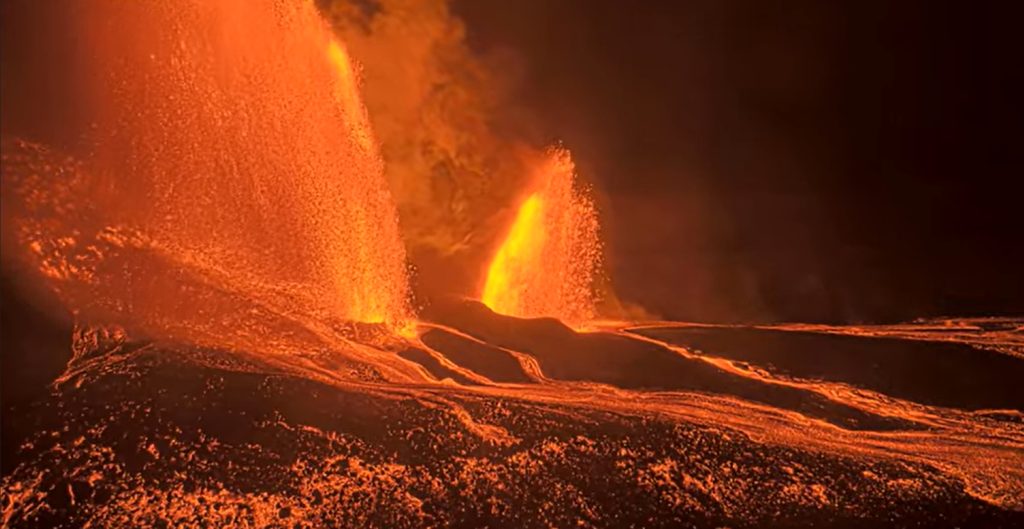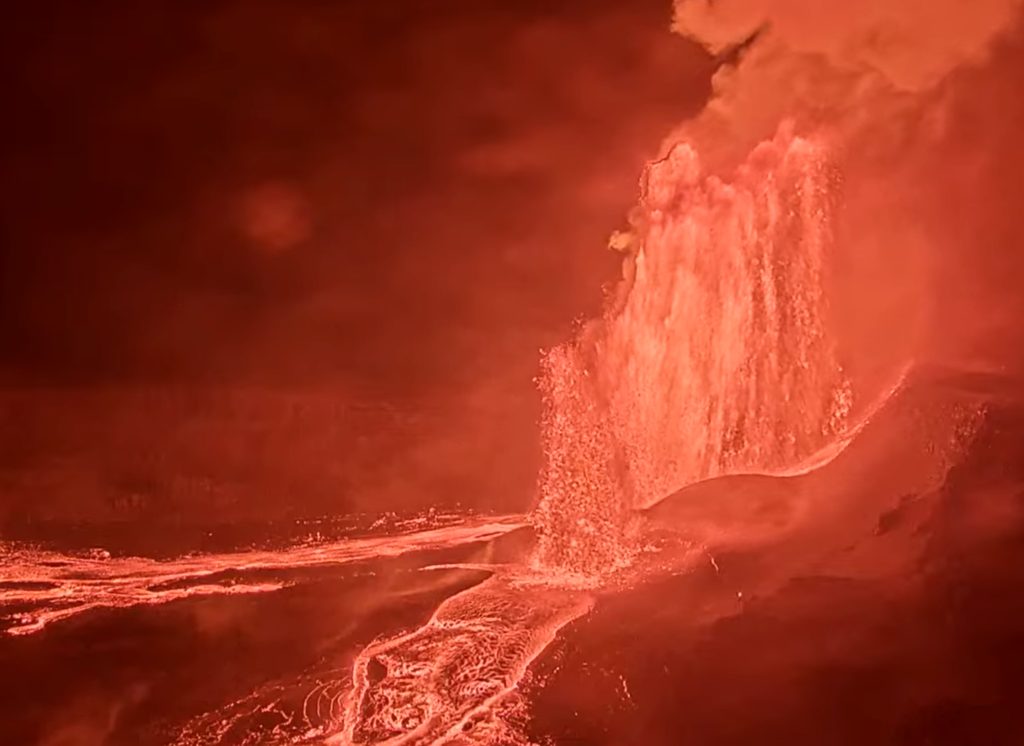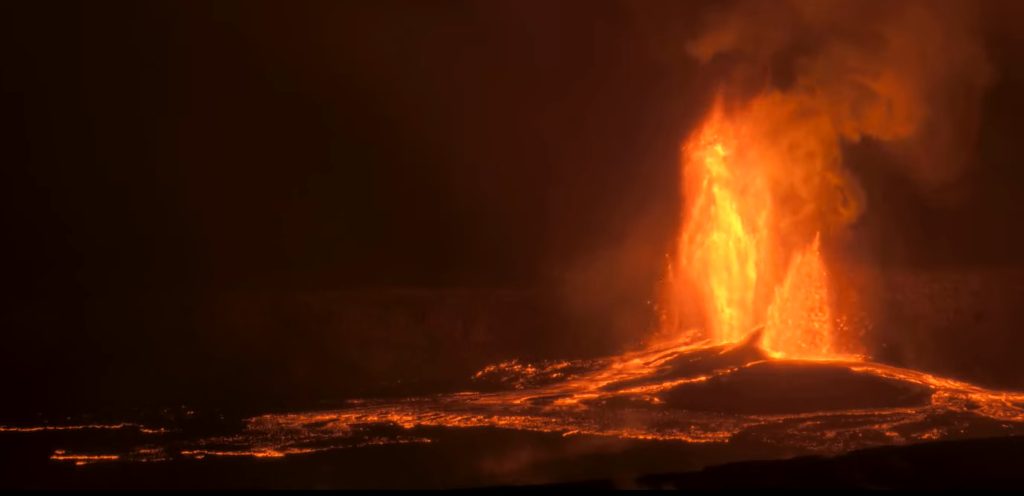Update: Kīlauea’s Episode 34 eruption ceases after six hours
Update, 8 a.m., Oct 1: Episode 34 of the ongoing Halemaʻumaʻu eruption ended abruptly at 7:03 a.m., on Oct. 1, after a little more than six hours of continuous fountaining.

The north vent began continuous fountaining at 12:53 a.m., and stopped erupting at approximately 7:03 a.m., marking the end of the episode.
The south vent erupted between 1:45-7:00 a.m.
Lava fountains from the north vent were angled to the northeast, while those from the south vent shot straight up, reaching an estimated height of 1,300 feet during this episode.
Approximately 8.9 million cubic yards of material were erupted during episode 34. Volcanic gas emissions have greatly decreased
Original Post: Episode 34 of the ongoing Kīlauea volcano summit eruption on the Big Island is underway — and this time it’s a dual fountain event.
Hawaiian Volcano Observatory reports that low lava fountains — about 30 feet high — began at 11:43 p.m. Sept. 30 feeding lava flows from the north vent in the southwest portion of Halemaʻumaʻu Crater.
Fountains began to increase in size and volume with the onset of deflation at 12:53 a.m. today, marking the beginning of Episode 34.
Fountains increased to 330 feet and inclined slightly to the northeast by 1:13 a.m., continuing to feed lava flows onto the crater floor.
The south and north vents were both fountaining lava as of 5:20 a.m. today as seen on the three livestream cameras overlooking the crater provided by the U.S. Geological Survey — V1cam, V2cam and V3cam.
Past episodes have produced incandescent lava fountains of more than 1,000 feet high with eruptive plumes up to 20,000 feet above ground level.
The National Park Service and a U.S. Geological Survey monitoring station are showing winds blowing moderately from the northeast, so while all eruptive activity is confined within Halemaʻumaʻu Crater inside Hawaiʻi Volcanoes National Park, volcanic gas and other volcanic material could be distributed to the southwest of the crater.
Forecasters at the National Weather Service office in Honolulu did issue a special weather statement for the Big Island concerning occasional small bursts of volcanic ash that continue to emanate from Halemaʻumaʻu.
Webcam and radar data indicate that low level trade winds will push ash toward the southwest, with any ash fallout likely occurring over Ka’u and Highway 11, southwest of Volcano, including the communities of Pāhala, Wood Valley, Nāʻālehu, Ocean View, Miloliʻi, Hōnaunau, Captain Cook and Kealakekua.

“In addition, any ash deposited over the last several days will likely be picked up by local winds, contributing to dusty conditions,” the special weather statement says.
The public is advised to avoid excessive exposure to ash — which is an eye and respiratory irritant. Those with respiratory sensitivities should take extra precaution to minimize exposure.
Episode 34 was preceded by more than 120 gas pistoning events producing small, sporadic spatter fountains of 10 feet and many resulting in short overflows.
These events began shortly before 10 p.m. Sept. 28 and continued to increase in frequency and intensity until they became rhythmic at 1:30 p.m. Sept. 29. The rhythmic gas pistons continued past midnight, but produced only 10 overflows in 100 events by 6:30 a.m. Sept. 30.
Gas pistoning continued and magma remained high in the north vent, with additional overflows from 2:22 p.m. to 6:50 p.m. Sept. 30.
Sustained overflow and low-level fountaining began nearly 5 hours later at 11:43 p.m.
Inflationary tilt reached 18 microradians since the end of the last episode. Seismic tremor began increasing and tilt switched from inflation to deflation with the onset of Episode 34.
Most episodes of lava fountaining since the ongoing episodic eruption started Dec. 23, 2024, continued for about a day or less and were separated by pauses generally lasting at least several days.
No changes have been detected in Kīlauea’s East Rift Zone or Southwest Rift Zone.
Kīlauea’s Volcano Alert Level remains at Watch and the volcano’s Aviation Color Code is still at Orange.

HAZARD ANALYSIS:
- ASHFALL: Small volcanic particles could impact downwind areas.
- VOLCANIC GAS: Emissions, which include sulfur dioxide (the main contributor of vog), are typically 50,000 tonnes/day during sustained lava fountaining episodes.
- LAVA FLOW: Confined to Halemaʻumaʻu Crater (within the summit caldera).
- OTHER HAZARDS: Pele’s hair and tephra.
Hawaiian Volcano Observatory continues to closely monitor Kīlauea. Email to askHVO@usgs.gov for additional information or any questions.



